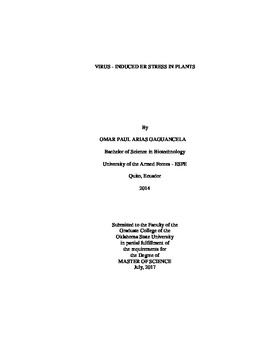| dc.contributor.advisor | Verchot, Jeanmarie | |
| dc.contributor.author | Arias Gaguancela, Omar Paul | |
| dc.date.accessioned | 2018-06-13T16:19:35Z | |
| dc.date.available | 2018-06-13T16:19:35Z | |
| dc.date.issued | 2017-07-01 | |
| dc.identifier.uri | https://hdl.handle.net/11244/300025 | |
| dc.description.abstract | The endoplasmic reticulum (ER) is a membrane system that acts as platform for RNA viral replication and movement. The potexvirus TGB3 and potyvirus 6K2 proteins cause alterations in the ER architecture and protein production, causing ER stress. Embedded in the ER membrane are ER stress sensors that detect malformed proteins and elicit signaling cascades that result in changes in nuclear gene expression, process known as unfolded protein response (UPR). The most conserved ER stress sensors are IRE1 (coded by IRE1a and IRE1b), and type II transmembrane (bZIP) named bZIP60, bZIP17 and bZIP28 transcription factors which enter the nucleus to recognize promoters to activate gene expression of chaperone binding protein (BiP) to restore homeostasis. BI-1 is a cell death suppressor that resides in the ER and is believed to be downstream of IRE1. The contribution of these ER sensors in virus pathogenicity is poorly understood. This study revealed that knockdown of ER stress sensors led to greater plant virus accumulation. PlAMV-GFP and TuMV-GFP accumulated to higher levels in Arabidopsis plants defective for both IRE1a and IRE1b than in wild-type Col-O. Interestingly, bZIP60 was a host susceptibility factor for both viruses, whereas bZIP28 and bZIP17 knockouts differentially accumulated PlAMV-GFP and TuMV-GFP in Arabidopsis plants. Agro-delivery of potexvirus TGB3 and potyvirus 6K2 resulted in elevated bZIP60, bZIP28 and bZIP17 transcript levels in Arabidopsis and N. benthamiana plants, which led to BiP gene activation. Arabidopsis plants defective for BI-1 were found to have a more significant effect on systemic PlAMV-GFP and TuMV-GFP accumulation than in bZIP60 mutant plants. Similarly, the experiments conducted in BI-1 and bZIP60 silenced N. benthamiana plants infected with PVX-GFP or PVY-GFP showed that knockdown of BI-1 produced higher virus accumulation levels than bZIP60. These data suggested that UPR pathways provide some protection against virus infection. | |
| dc.format | application/pdf | |
| dc.language | en_US | |
| dc.rights | Copyright is held by the author who has granted the Oklahoma State University Library the non-exclusive right to share this material in its institutional repository. Contact Digital Library Services at lib-dls@okstate.edu or 405-744-9161 for the permission policy on the use, reproduction or distribution of this material. | |
| dc.title | Virus - Induced ER Stress in Plants | |
| dc.contributor.committeeMember | Walker, Nathan | |
| dc.contributor.committeeMember | Garzon, Carla | |
| osu.filename | ARIASGAGUANCELA_okstate_0664M_15251.pdf | |
| osu.accesstype | Open Access | |
| dc.description.department | Entomology & Plant Pathology (MS) | |
| dc.type.genre | Thesis | |
| dc.type.material | text | |
